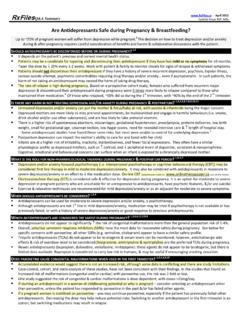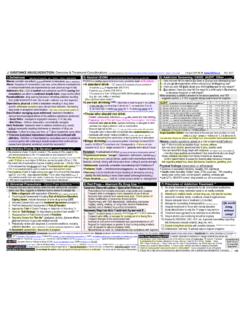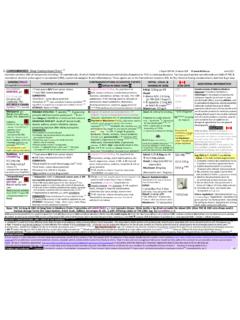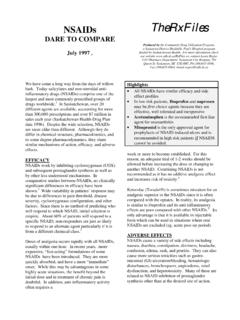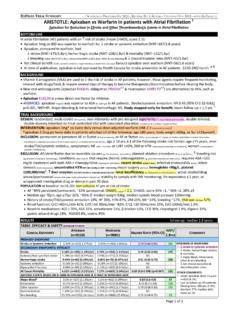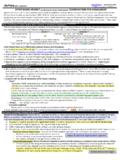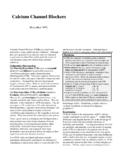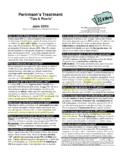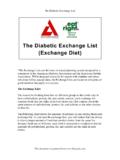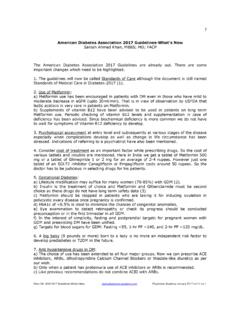Transcription of Type 2 Diabetes (T2DM) - RxFiles
1 Recent Guidelines: Canadian: Sept 2008 1 2003: American (ADA): Jan 2008 2 ; Oct 2008 Update 28; NICE (UK): May 2008 3 ; CKS (NHS): Systematic Reviews: COMPUS: Insulin Analogues4 Also CMAJ Feb09 29,30,31 Long-acting vs NPH in T2DM Cochrane Apr 20075 Long-acting vs Intermediate in T1DM Cochrane Jul 20086 Rapid Acting vs Regular in DM Cochrane Apr 20067 Review Articles: Tibaldi: Insulin in T2DM Am J Med 8 Hirsch: Insulin Analogues NEJM 9 Drugs for T2DM; Medical Letter Treatment Guidelines Jul 200810 Screening tools: Patient Resources: Highlights: 1) Individualize glycemic control targets considering patient and intervention factors.
2 2) Use metformin first-line as monotherapy and maintain in combination therapies, including with insulin, unless contraindicated. 3) Discuss insulin early on to gain patient buy-in for when it may be needed. 4) To make starting insulin safer & easier, use a low dose of a basal insulin at bedtime ( NPH/N 5-10 units). 5) Newer long-acting insulin analogues may be considered over NPH/N if hypoglycemia, (especially nocturnal) is a problem. RxFiles Diabetes Charts: 1) Approach T2DM/Hypoglycemics 11 2) Insulin Comparison 12 3) Insulin Management 13 4) Landmark Diabetes Trials 14 5) Insulin Devices / Pens 12 b see T2DM: Treatment of Hyperglycemia Individualize Targets: Intensive treatment of hyperglycemia predominantly results in reduced microvascular , 16 Two large RCTs have found that more-intensive lowering of plasma glucose (PG) does not reduce CV events, and may be associated with increased risk of major hypoglycemia & all-cause death in some patients (ACCORD17, ADVANCE18).
3 Thus, targets for glucose control need to be individualized taking into account both patient and intervention factors ( weight, CV risk, age, # of drugs required, hypoglycemia).1 {See Landmark Trials chart, pg 28 14}. Table 1: Recommended glycemic control targets 1 AdultA1C % FPG mmol/L 2hr-PPG mmol/L 7* 4-7 5-10 (or 5-8**) {Individualize targets! Allow 6-12 months to reach target A1C.} FPG=fasting plasma glucose (or preprandial plasma glucose) PPG=postprandial plasma glucose PG= plasma glucose *a target of may be considered in some T2DM patients to lower risk of nephropathy, but this must be balanced against the risk of hypoglycemia & mortality in high CV risk patients ** consider a PPG target of 5 - 8 if A1C targets not being met Multifactorial intervention key: Lifestyle changes, antihypertensives, statins, ASA and hypoglycemics are important for reducing cardiovascular 19 Metformin (MF): MF is recommended as the initial agent in most patients1,28 due to its effectiveness in.
4 O reducing all cause mortality (in obese) UKPDS-34 20 o lowering PG without weight gain and with a relatively mild side effect 20,21 Stepping up from Metformin; Orals or Insulin: o Other hypoglycemics or insulin may be needed for marked hyperglycemia or achieving targets. o The optimal 2nd agent will depend on the pattern of hyperglycemia, plus patient and safety factors { HF, renal failure, pre- vs post-prandial, hypoglycemia, SE, cost}. o Consider early initiation of insulin especially if A1C 9%, metabolic decompensation or poor PG control. {See Approach to Type 2 DM chart, pg } o Avoid using insulin as a threat . It will eventually be needed in many T2DM patients.
5 Current Uncertainties: o Benefits vs risks of tighter PG or A1C control. 22,23 o TZDs especially rosiglitazone: potential adverse CV outcomes. 24 o Role of sitagliptin JANUVIA new incretin; good PPG control & weight neutral, but lack outcome & safety ,28 {See related Trial Summaries and Q&As at } Approach to Initiation of Insulin in T2DM {adapted from Knowledge Support Service, CEP, } What is the best initial regimen to use in T2DM? Consider bedtime insulin (NPH/N, glargine or detemir) as it is effective, convenient, and relatively easy to accept and initiate compared to multiple daily doses. 26 A common starting dose is 5-10 units at hs.
6 Increase dose gradually ( 2 units q 2-3 days) till @ target. {See Insulin Management Chart: Initiating Insulin, pg 27-b 13} Daytime oral hypoglycemics, especially metformin, should often be continued to optimize management (minimizes insulin dose and weight gain). Should I use NPH/N, glargine or detemir? There are no clinically important differences on ,5,27 Glargine and detemir cause somewhat less hypogly-cemia but are more costly than NPH. (See Table 3).4,5 Differences in weight gain are summarized in Table 3. They are small (<1kg) and of uncertain significance. The COMPUS clinical & economic review 4,29,30,31 concluded NPH was a preferred initial agent whereas Canadian Guidelines1 note long acting analogues may be considered instead of NPH to reduce the risk of nocturnal and symptomatic hypoglycemia.
7 What about more intensive insulin in T2DM? A more intensive insulin regimen will sometimes be necessary. Such regimens achieve better glycemic control at the expense of weight gain, hypoglycemia and regimen complexity. It is easier to use such regimens after patients are comfortable with insulin and the associated monitoring. A short acting (regular) or rapid acting insulin (lispro or aspart) W given around meals will allow tighter glucose control. Premixed insulin BID may be useful in some patients. {See Insulin Charts, pg 26-a & 26-b for more ,13} Table 2: Starting Insulin; tips for patient buy-in 25 Discuss insulin early to change negative insulin perceptions Provide information pertaining to insulin benefits Consider suggesting a trial for 1 month Discuss the relative ease of using the newer insulin devices ( insulin pens.)
8 Smaller needle) compared to syringe/vial Link patient to community support such as a Certified Diabetes Educator (CDE) for education on injections & monitoring Ensure patient has time to get comfortable with loading and working a pen (or syringe) Refer patient for nutrition & physical activity counseling Type 2 Diabetes (T2DM) Update & Focus on Insulin Management Issues October 2008 Table 3: Systematic Review of Insulin Trials: Basal Insulin + Oral Agents in Adults with T2DM 4,5 Glargine LANTUS vs NPH / N Detemir LEVEMIR vs NPH / N A1C% Not significant ( CI: ) {9 trials; n=3397} Slight by detemir ( CI: ) {3 trials; n=1159} Hypoglycemia, Nocturnal Less with glargine: Risk ratio: (CI: ) {7 trials; n=2866; Estimated NNT=7 CI: 6-9; over 4wk-1yr; baseline risk 33%} {No significant difference in Severe (Risk ratio: CI: )} Less with detemir: Risk ratio: ( ) {2 trials; n=808; Estimated NNT=6 CI: 4-33; over 20-24wks; baseline risk 33%} {No significant difference in Severe (Risk ratio: CI: )} Weight Change Not significant; (glargine wt by CI: to , 7 trials) Detemir wt by (CI: to , 3 trials) Cost 15ml/month Glargine: $105; NPH/N: $50 {5x3ml cartridges} Detemir: $135.
9 NPH/N: $50 {5x3ml cartridges} Other Once daily dosing Some patients will require twice daily dosing* *If BID needed, dose required 2x & wt gain advantage lost vs daily {See also Insulin Management IAs: Guide to Advantages/Disadvantages, pg } No clinically important differences. RxFiles Academic Detailing Service Saskatoon City Hospital, 701 Queen Street, Saskatoon, SK S7K 0M7 Overview of the RxFiles Diabetes Charts Oct 2008 {Pages 24-28 of the RxFiles Drug Comparison Charts 7th Edition Book (Oct08)} Page Chart Title & Contents Highlights 24 Approach to Management of T2DM in Adults Approach .. Individual: Special Considerations Table 6 Combination Therapies Table 7 Start Metformin (MF) low dose (250 or 500mg once daily) & titrate.
10 Metformin dose adjustment for renal fx (30-60ml/min) {recent guidelines noted option of using MF lower than official monograph.} More cautious approach to targets and dosing in the elderly Options for post-prandial glucose control Table 6 25 Oral Hypoglycemics Glyburide: consider use in lower end of dosage range ( BID) Repaglinide Gluconorm: short-acting & allows flexibility for meal intake PPG: limited observational data suggests predictor of CV disease 26-a Insulin Comparison Chart Comparison of various insulin regimens (daily, BID, TID+/- HS) & cost Premixed: suitable for some ( less-intensive, institutionalized) 26-b Insulin Management.
